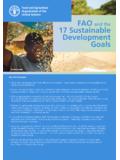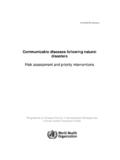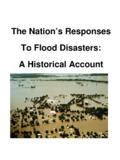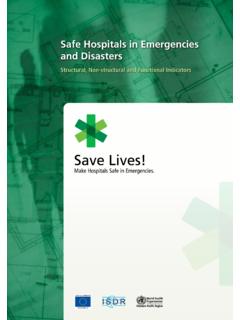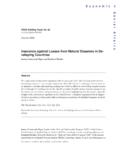Transcription of The Impact of Disasters on Development Gains: …
1 The Impact of Disasters on Development Gains: clarity or ControversyAllan LavellLatin American Social Science Faculty (FLACSO) and The Network for the Social Study ofDisaster Prevention in Latin America-LA RED. July Presented at the IDNDR Programme Forum, Geneva, 5-9th July 1983, Fred Cuny published his seminal work on Disasters and Development . Although a number ofstudies had been published previously on the theme of Disasters and social change, Cuny provided afirst systematized and comprehensive series of ideas on the ways Disasters may interruptdevelopment processes, whilst, at the same time, offering opportunities for future considerations were added to this debate during the eighties, particularly by Mary Anderson(1985; 1989). By the end of the decade the theme of Disasters , environment and sustainability hadalso been vented in a number of works edited by Kreimer (1989), Kreimer and Zador (1989) andKreimer and Munasinghe (1991).
2 During the present decade, the debate on disaster - Development relations and the analysis of theirpractical implications for risk and disaster management finally came of age. The theme has nowbecome an almost obligatory point of reference and reflection when discussing the topic of is the product of various circumstances amongst which, particular importance may be attributedto: a)the IDNDR and it's emphasis on risk reduction and mitigation; b)the outstanding economic lossesassociated with Hurricane Andrew, the Mississippi floods and the Kobe earth-quake during the firsthalf of the decade; c)the generally accepted fact that the number and human and economic Impact ofdisasters is rapidly increasing at a world level, with the developing countries and their poorerpopulations suffering an undue amount of the burden;d) the idea that such factors as global climaticchange, the introduction of new untried technologies and increased social vulnerability may provideconditions for more and larger Disasters in the future.
3 Towards the end of the decade, the debate hasbeen fuelled by the recent impacts of such phenomena as El Nino and Hurricanes George and Mitchin Latin America and the Caribbean. One of the results if not one of the causes of the growing concern for the Development Impact ofdisasters has been an increase in the number and types of institution involved with the disasterproblematic. These are no longer limited to the humanitarian preparedness and responseorganizations as was essentially the case towards the end of the last decade. Increasingly over thelast few years, a number of the major " Development " institutions have become more closely involvedwith the problem. This includes the World Bank, the Inter American and Asian Development Banks,the United Nations Development Programme and Germany's GTZ. Moreover, El Nino, George andMitch had a significant Impact in terms of the visible presence of a number of the more importantorganizations concerned with environmental problems and management.
4 The principle objective of this short paper is not to provide an analysis or evaluation of the impacts ofdisasters on Development as such. This, as we hope to demonstrate, is difficult to achieve given thepresent way in which disaster Impact data are presented and analyzed. Rather, we will concentrate ona series of what we consider to be important partialities, misrepresentations, inaccuracies, distortions,and fallacies in the ideas and direction of the arguments put forwards as regards the relationshipbetween Disasters and Development . Given the space available it is not possible to fully develop and document our arguments. Rather, weprovide a somewhat sketchy and intuitive picture that we hope provides sufficient material to generatean interesting debate. Little of what we will argue has not been argued previously in one way oranother. However, it does seem necessary to reiterate certain arguments in order to attempt toachieve some sort of consensus as regards the real nature of the disaster problematic and of theparticular relations that exist between Disasters and Development .
5 Six basic premises inform our comments and analysis. These are also conclusions. Firstly, any serious analysis of the disaster - Development problem must use a temporal framework thatguarantees that the full "life cycle" of a disaster can be closely examined, and not just the short-termperiod immediately after disaster occurs. Secondly, large-scale events should not typify and dominate the problem of disaster (Hewitt, 1983).More concern should be given to the wide range of lower level damaging events that recurrently affectdifferent regions, localities and communities throughout the world. Thirdly, the statistics produced to date on disaster impacts are not particularly conducive to anydetailed analysis of the disaster - Development problem. Other uses and attributes they may well have,but a comprehensive analysis of the disaster - Development question is not amongst these. Fourthly, concentration on the question of the impacts of Disasters on Development basically serves asa distraction from the fundamental question, which is the Impact of Development on Disasters .
6 Only byresolving this latter question will we ever get anywhere in terms of risk and disaster mitigation, and,consequently, in terms of reduced disaster impacts. Fifthly, the basic problem is not that Disasters may have important negative developmentconsequences, particularly where their Impact is large relative to the size of the affected , the real problem is the reduced size and/or level of Development of the affected economy andsociety. Instead of satanizing hazards for their impacts on society, it would be probably be morecorrect to satanize society for its impacts on hazards! And, lastly, the use of economic criteria and cost-benefit equations for attempting to justify riskmitigation and reduction may reap rewards for the modern sector economy, but this is not the case forthe poor and traditional sectors that make up the majority of the victims of disaster . The attainment ofsecurer living conditions for the poor and a substantial reduction in their vulnerability is more a case ofethics, equity and social justice, than economic rationale and this paper our arguments are particularly directed at the problem of disaster in developingworld counties.
7 Many of our arguments are illustrated using the case of Mitch in Central America as anexample. However, these arguments are, we believe, generally valid. A Critical Problem:The Need for an Adequate Temporal Base for an Analysis of the disaster - Development and disaster are complex social problems. Many partial disciplinary approaches to their studyhave been promoted with important analytical and practical results. Despite this, the complex nature ofthe topic also requires integrated, holistic approaches that are capable of providing a general theory ofdisaster. Partial approaches often lead to partial or biased conclusions. The disaster -developmentdiscussion has suffered from this problem. Amongst the problems confronted, the use of inadequatetemporal analytical frameworks is of particular importance. Disasters , in the same way as other types of economic or social crises, have a life history. Thisincludes the period of maturation in which the structural conditions for disaster are established, theperiod of onset and Development of disaster conditions as such, and the subsequent responses ofsociety during what are known as the relief, rehabilitation and reconstruction "phases".
8 In the jargon ofdisaster experts these distinct moments are somewhat inaccurately portrayed as the before , during and post disaster stages. Although it may be convenient to use this distinction between different moments or stages for certainanalytical and practical purposes, at other times it clearly leads to a distorted, partial or inaccuratedepiction of reality. With reference to the disaster - Development problem it is our belief that an accurateand relevant assessment of this can only be achieved using an integrated temporal framework foranalysis. One that considers disaster causes, consequences and social response in the sameanalytical framework. This signifies that if we are to achieve an adequate balance as regards theinterpretation of the Impact of disaster on Development , we must also consider the ways in whichdifferent models and patterns of economic growth have contributed to the very disaster conditions weare analyzing.
9 These two "moments" can not be considered apart as if they were two differentproblems. Using an analogy with human growth and Development , it is impossible for us to fullyunderstand the stage of adolescence and it's significance for adult growth without understanding theprocess of growth and Development during to the above criteria, we will begin our argument analyzing the factors that contribute to thecreation of risk in society and, consequently, to the conditions that permit that Disasters occur. In otherwords we will briefly examine the ways in which processes of social change, growth and developmentlead to the creation of vulnerability and risk. Risk: A Structural Component or Forgotten Dimension of Economic Growth Models? disaster Impact , loss of infrastructure, production and human life are, except in very exceptionalcases, directly related to the levels of preexisting social vulnerability. The types, structure and levels ofvulnerability that exist when the event occurs precondition the damage any particular physical eventcan cause ( Blaikie et al, 1994; Hewitt,1997).
10 Vulnerability is the result of ongoing social processes. Itis socially constructed. These processes are consequences or components of the different styles ormodels of economic growth and social change adopted by or imposed on different countries orsocieties. Here, it is probably fair to say that different growth models have different consequences andmanifestations of risk and vulnerability. Some expression of risk and vulnerability is inherent to, orstructurally determined by the types of social process that typify these different models. Althoughpoverty and vulnerability are not in themselves synonyms, it is generally accepted that povertyexplains a significant part of the vulnerability that affects the vast majority of the population of thedeveloping countries affirmations characterize what is known as the Vulnerability Paradigm of disaster premises are, of course, open to discussion.


